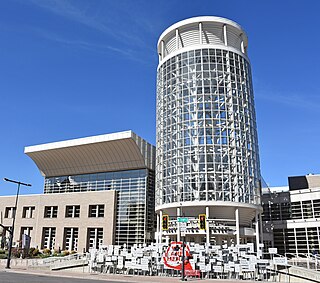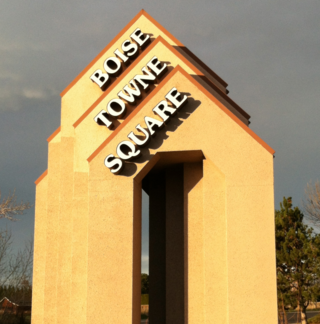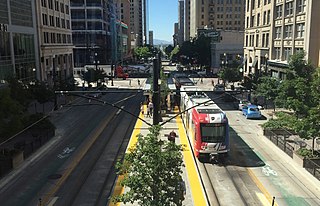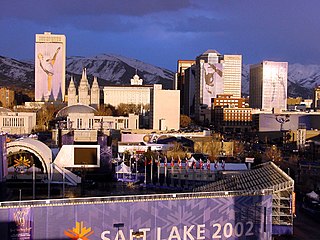
Salt Lake City, often shortened to Salt Lake or SLC, is the capital and most populous city of the U.S. state of Utah. It is the county seat of Salt Lake County, the most populous county in the state. The city is the core of the Salt Lake City Metropolitan Statistical Area (MSA), which had a population of 1,257,936 at the 2020 census. Salt Lake City is further situated within a larger metropolis known as the Salt Lake City–Ogden–Provo Combined Statistical Area, a corridor of contiguous urban and suburban development stretched along a 120-mile (190 km) segment of the Wasatch Front, comprising a population of 2,746,164, making it the 22nd largest in the nation. With a population of 200,133 in 2020, it is the 117th most populous city in the United States. It is also the central core of the larger of only two major urban areas located within the Great Basin.

Murray is a city situated on the Wasatch Front in the core of Salt Lake Valley in the U.S. state of Utah. Named for territorial governor Eli Murray, the city had a population of 50,637 as of the 2020 United States Census. Murray shares borders with Taylorsville, Holladay, South Salt Lake, Millcreek and West Jordan, Utah. Once teeming with heavy industry, Murray's industry mix has now shifted significantly toward healthcare, retail, and professional, scientific, and technical services. Known for its central location in Salt Lake County, Murray has been called the Hub of Salt Lake County. Unlike most of its neighboring communities, Murray operates its own police, fire, power, water, library, and parks and recreation departments and has its own school district. While maintaining many of its own services, Murray has one of the lowest city tax rates in the state.

Zion's Co-operative Mercantile Institution (ZCMI) was an American department store chain. It was founded in Salt Lake City, Utah, on October 9, 1868, by Brigham Young. For many years it used the slogan, "America's First Department Store."

The Calvin L. Rampton Salt Palace Convention Center, more commonly known as the Salt Palace, is a convention center in Salt Lake City, Utah. Named after Utah's 11th governor, Calvin L. Rampton, the moniker "Salt Palace" was previously used by two other venues in the city.

Sugar House is a neighborhood in Salt Lake City, Utah. The name is officially two words, although it is often colloquially written as "Sugarhouse." As a primary commercial and residential hub of the region, it is often referred to as Salt Lake's "Second Downtown." Once a primarily residential area with a suburban-style retail hub, the neighborhood has transformed in recent years as mid-rise offices, residential blocks, and hotels have been constructed in the vicinity of Sugar House Park.

Salt Lake City, Utah has many historic and notable sites within its immediate borders. Although the entire Salt Lake City metropolitan area is often referred to as "Salt Lake City", this article is concerned only with the buildings and sites within the official city limits of Salt Lake City.

Originally, the Salt Lake Valley was inhabited by the Shoshone, Paiute, Goshute and Ute Native American tribes. At the time of the founding of Salt Lake City the valley was within the territory of the Northwestern Shoshone, who had their seasonal camps along streams within the valley and in adjacent valleys. One of the local Shoshone tribes, the Western Goshute tribe, referred to the Great Salt Lake as Pi'a-pa, meaning "big water", or Ti'tsa-pa, meaning "bad water". The land was treated by the United States as public domain; no aboriginal title by the Northwestern Shoshone was ever recognized by the United States or extinguished by treaty with the United States. Father Silvestre Vélez de Escalante, a Spanish Franciscan missionary is considered the first European explorer in the area in 1776, but only came as far north as Utah valley (Provo), some 60 miles south of the Salt Lake City area. The first US visitor to see the Salt Lake area was Jim Bridger in 1824. U.S. Army officer John C. Frémont surveyed the Great Salt Lake and the Salt Lake Valley in 1843 and 1845. The Donner Party, a group of ill-fated pioneers, traveled through the Great Salt Lake Valley a year before the Mormon pioneers. This group had spent weeks traversing difficult terrain and brush, cutting a road through the Wasatch Mountains, coming through Emigration canyon into the Salt Lake Valley on August 12, 1846. This same path would be used by the vanguard company of Mormon pioneers, and for many years after that by those following them to Salt Lake.

TRAX is a light rail system in the Salt Lake Valley of Utah, in the United States, serving Salt Lake City and many of its suburbs throughout Salt Lake County. The system's official name, Transit Express, is rarely, if ever, used. The system is operated by the Utah Transit Authority (UTA). All TRAX trains are electric, receiving power from overhead wires.

Downtown is the oldest district in Salt Lake City, Utah, United States. The grid from which the entire city is laid out originates at Temple Square, the location of the Salt Lake Temple.

Boise Towne Square is a mall in the western United States, located in Boise, Idaho. The largest retail complex in the state, it opened in 1988 after more than 20 years of planning, and features 150 stores, with Macy's, JCPenney, Kohl's and Dillard's as anchor stores. The mall also includes the first Apple Store in Idaho. Boise Towne Square is owned by the Chicago-based Brookfield Properties and is located near the junction of Interstate 84 and Interstate 184.

The ZCMI Center Mall was a shopping mall in downtown Salt Lake City, Utah, that operated from 1975 to 2007, before being demolished to make way for City Creek Center. The mall was developed and owned by Zions Securities Corporation, a for-profit entity owned by the Church of Jesus Christ of Latter-day Saints. The mall was located kitty-corner from the church's Temple Square.

City Creek Center (CCC), commonly shortened to City Creek, is a mixed-use development containing an upscale open-air shopping mall, grocery store, and office and residential buildings near Temple Square in downtown Salt Lake City, Utah, United States. Opened on March 22, 2012, the development encompasses over 23 acres (9.3 ha) across portions of three city blocks. The center's mall includes a foliage-lined walkway with a simulated stream, meant to recreate City Creek, an important water source for the early settlers of Salt Lake City.
Valley Fair Mall is a 831,667-square-foot (77,264.4 m2) single-level regional shopping center located in West Valley City, Utah, United States. Anchor stores are All Star Bowling & Entertainment, Hobby Lobby, JCPenney, Megaplex Theatres, Old Navy, Ross Dress For Less, and Ulta Beauty.

Arena station is a light rail station in Downtown Salt Lake City, Utah, in the United States, served by the Blue Line and Green Line of the Utah Transit Authority's (UTA) TRAX system. The Blue Line has service from the Salt Lake Intermodal Hub in Downtown Salt Lake City to Draper. The Green Line has service from the Salt Lake City International Airport and to West Valley City via Downtown Salt Lake City.

City Center station is a light rail station in Downtown Salt Lake City, Utah, in the United States, served by the Blue Line and Green Line of the Utah Transit Authority's (UTA) TRAX system. The Blue Line has service from the Salt Lake Intermodal Hub in Downtown Salt Lake City to Draper. The Green Line provides service from the Salt Lake City International Airport to West Valley City.
Crossroads Plaza was a shopping mall in downtown Salt Lake City, Utah, United States that operated from 1980 to 2007, before being demolished to make way for City Creek Center mall.

The 2002 Winter Olympic Games were held in and around Salt Lake City, United States from February 8 to 24, 2002, and the Paralympics from March 7 to 16, 2002. The sporting events were held in ten competitive venues, while non-competitive events, such as the opening ceremony, were held in six other venues. Three venues were also created for training purposes. All Olympic venues were scattered throughout Northern Utah and the Wasatch Front.

Main Street is the most important commercial street in Salt Lake City, Utah, United States though it also extends south into the cities of South Salt Lake, Millcreek, and Murray. Its commercial importance is almost totally derived from the few blocks of the street which are immediately south of Temple Square that have attracted banks, major retailers, and heavy foot traffic throughout Salt Lake City's history; the long southern extension of Main Street south of about 500 and 600 South, in contrast, is always in the shadow of State Street, which is more designed for the long-distance automobile traffic that is common away from downtown.

Fashion Place is an upscale shopping mall in Murray, Utah, United States. It opened in 1972, and is currently anchored by Nordstrom, Crate & Barrel, Macy's, and Dillard's.

The ZCMI Cast Iron Front is a historic building façade, currently attached to City Creek Center facing Main Street in downtown Salt Lake City, Utah, United States. The façade, built of cast iron and stamped sheet metal between 1876 and 1901, is a well-preserved example of a metal façade, and a reminder of the city's 19th-century commercial past. It was listed on the National Register of Historic Places in 1970.


















